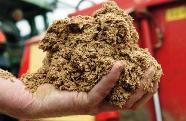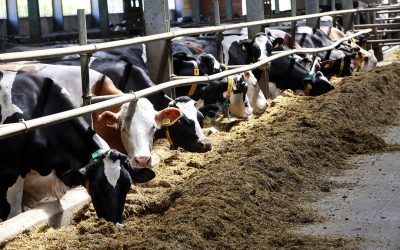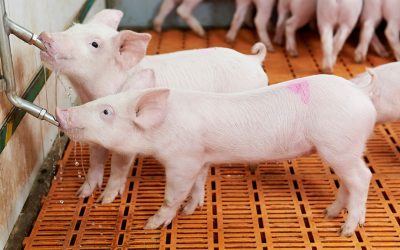Wet feeds – opportunity or clever disposal of offal?

With skyrocketing prices for regular feed raw materials feedmillers and farmers more and more become interested in alternative ingredients. In The Netherlands a lively industry was developed in valuing by-products from the food industry. Recently new nutritional tables became available for calculating the right feed formulas that include these wet feeds.By Dick Ziggers
The food, beverage and
fermentation industry produces a large volume of wet, liquid and moist
by-products (wet feeds). These products are often not suitable for human
consumption and have to be disposed of in other sectors. Because of costs and
sustainability these products find their way directly more and more on the farm
to be fed to pigs, beef and dairy cattle. More important is their nutritional
value as an animal feed.
Most of them can be considered valuable raw materials. And since
these products are derived from human grade materials their safety is without
question. Nutritional values of wet feeds however have not been adjusted since
1999. This was the reason that Schothorst Feed Research on behalf of the
Concession Group Wet Feeds (OPNV), a group representing wet feed suppliers in
the Netherlands and Belgium, have put together a new set of product sheets with
the most recent nutritional values of available wet feeds in the Netherlands.
This should help farmers to calculate their rations to proper feed standards on
their farms.
Prinsen)
Dutch
farmers in 2006 fed more than 5.15 million tonnes of wet feeds to their animals,
equalling to around 1 million tonnes of compound feed. This reflects 7% of total
Dutch compound feed production of 13.745 million tonnes. The products were
either supplied as single raw products or as standard mixtures. With these
volumes wet feeds have become an integral part of the Dutch feed industry. It is
argued that the use of wet feeds contributes to sustainability because producers
of these feeds can save on energy, CO²-emissions and costs when they can sell
the products in a wet form and do not need to dry them. It is important though,
that the products can be supplied within a reasonable distance from the
processing plant, because dry matter content is low, which makes transport cost
high per unit of dry matter. Not all wet byproducts find their way into animal
feed. The alcohol, bio ethanol and biogas industry is another useful outlet for
nutritionally less interesting wet products.
The pig industry purchased 3.25 million tonnes of wet feeds in
2006. Main products used in this sector were wheat starch products, steamed
potato peelings and whey products. The use of concentrated wheat yeast is
increasing. Dutch cattle consumed 1.9 million tonnes of wet feeds in 2006. Here
the main products are brewers grains, beet pulp and potato pulp. A relatively
new product is distillers grain solubles. The cereal and potato processing
industry are the largest suppliers of wet feeds to the Dutch animal sector,
taking about 3.5 million tonnes of the total amount of wet feeds sold. Other
suppliers of wet feeds are the sugar industry (507,000 tonnes in 2006), Dairy
industry (785,000 tonnes), fermentation and alcohol industry (250,000 tonnes)
and other products (140,000 tonnes). One third of the volume of 5.15 million
tonnes is supplied from other countries neighbouring the Netherlands (Germany,
Belgium, France and UK).
Loading of brewers grains at brewery.
To obtain starch and gluten
from wheat many valuable products for animal feed are produced. During
processing starch for human consumption and technical uses a few products are
separated that are of interest to be used as animal feed, such as wheat mix or
wheat middlings, glucose syrup and concentrated wheat yeast. Wheat middlings has
a pH between 2 and 4 which makes it last longer. It needs to be
stored in acid resistant silos and to avoid sinking of the solids it needs to be
stirred regularly. Wheat middlings have a high energy content and are very
suitable for pig feeds. Uptake can be as much as 30% of the daily ration.
Several products arise from the beer making process that find their way into
animal feed. Usually barley is used as the main raw material for beer. The best
known wet feed from the beer industry are brewers grains, which has 22% dm and
is mostly fed to cattle and to a lesser extent to pigs.
thus are a valuable raw material for ruminants. It also has a positive effect on
the concentration of volatile fatty acids, which improves the functioning of the
rumen. In pigs brewers grains is fed to gestating sows because of the high level
of fibre. Depending on the beer making process pressed middlings can also be
left over, which contains on average 28% dm and is sold as animal feed. Brewers
do not want too much protein in the process, so the proteins are coagulated and
mixed into the brewers grains. In addition, remains of hops are mixed into it.
Hops is bitter and negatively influences the uptake by the animals, but nowadays
almost all brewers use concentrated hops, in which the bitterness is absent.
Yeast in brewing is used to ferment the sugars into alcohol and after this
process the yeast is recovered from the process and sold as brewers’ yeast for
pig feeding. Beer that is unfit for human consumption is sold as feed because of
the alcohol content, which has a positive effect on silence in the pig stable.
In maize processing (for starch) a few products are obtained that can be used as
wet feeds.
produced after the maize has been soaked in hot water. When protein (gluten) and
starch is removed from the maize kernel the left over fibres are mixed with the
concentrated soak water and sold as corn gluten feed. To obtain glucose from
corn starch enzymes are used and to obtain pure clear corn glucose the syrup is
filtered. This product is called maize-energy (‘maïsinol’) and is a high energy
product containing dextrose and easy digestible fats which makes it very
suitable to feed to young animals.
A truck driver of wet feed trader Duynie is delivering
steamed potato peels to one of the silos of a pig farmer.
The potato industry is another important supplier of by
products that can be used as animal feed. In the starch industry potatoes with
high starch content are used. The potatoes are washed and then mashed, which
releases the starch from the cells. The mash is separated in three streams:
potato starch, potato juice and potato fibres. Potato starch has in many uses.
Potato juice has a high protein content, which is recovered and marketed as
potato protein. It is a useful protein source for young animals. Potato fibres
are dewatered to a dry matter content of 16.5% and then sold as potato pulp.
This product contains ground peels, cell walls, leftover starch and juice. It is
used in cattle feed as an energy source. Potatoes used for (in) direct
consumption supply a whole list of by-products depending on the processing steps
used.
are treated with steam and then are peeled or brushed. Apart from the peels a
small layer of starch is removed and because of the steam treatment this starch
is well disclosed. The starch content depends on the quality of the potatoes
used. Potato scraps are produced when the potatoes are cut up and certain parts
are unfit for making deep-fry products. The starch in this product is similar to
that of the raw potatoes and is difficult to digest by pigs, but an interesting
product for ruminants because of the high rumen by-pass content. Potato scraps
are tasty and rich in energy. Cooked potato products are the leftovers from
potatoes that have been processed into French fries or other fried products. The
product becomes available at start-up and finish of a batch and after sorting of
fried products. The fat in the product comes from the cooking oil and
nutritional content depends on the type of oil used. The heat treatment is
enough to release the starch, which makes the product suitable for pigs.
potatoes for fries of crisps. The starch in the cutting water is centrifuged to
separate the solid fraction from the water. The product is used in cattle
feeding because of the high rumen by-pass starch content. To make it suitable
for pig feed it needs to be heated. Other products from the potato industry are
granules and flakes, both by-products from the mashing process. Potato granules
have 65% dm content, flakes even higher. Ground-up potato crisps also find their
way in pig feed, when they are rejected at the processing plant.
Because wet feeds contain a high percentage of
water they are vulnerable to bacterial growth. Good general hygiene in storage
of the products is recommended. The huge variety in wet feeds makes it difficult
to set a general rule for conservation. There is a critical balance between
keeping the product fresh and letting it deteriorate by micro-organisms (yeasts,
bacteria en fungi). By adding specific organic and inorganic acids or through
natural acidification bacterial growth can be reduced, which contributes to a
longer conservation period.
products are supplied at temperatures as high as 85°C. Such products need to be
stored in well insulated tanks. Wet feeds in pig feeding are solely used by
farmers that use a liquid feeding installation and have their own feed kitchen
to prepare the mixtures. In cattle feeding TMR (total mix ration) is an
excellent system to feed wet feeds. Many products ferment during storage; the
content of sugars and starch decreases and the lactic acid, acetic acid and
alcohol content increases. Several trials have shown that feeding fermented
products and fermented liquid feed have a positive influence on pig performance,
although there are different theories on the mechanism of this process.
Feed
Research, Lelystad, The Netherlands
Email: info@schothorst.nl
–To see
table; Wet feeds for on farm feeding from the cereal, potato and fermentation
industry, please click on pdf link below.
 Beheer
Beheer









 WP Admin
WP Admin  Bewerk bericht
Bewerk bericht